Case Study- Claymore Consultants
VerifiedAdded on 2022/11/13
|13
|3094
|227
AI Summary
Read this case study on Claymore Consultants, a management consulting firm of Australia. Identify the change indicators within the structures, processes and boundaries framework of Claymore Consultants and analyze the current situation of the company accordingly. Get recommendations to help the company grow and survive the competitive market of professional consulting service industry.
Contribute Materials
Your contribution can guide someone’s learning journey. Share your
documents today.
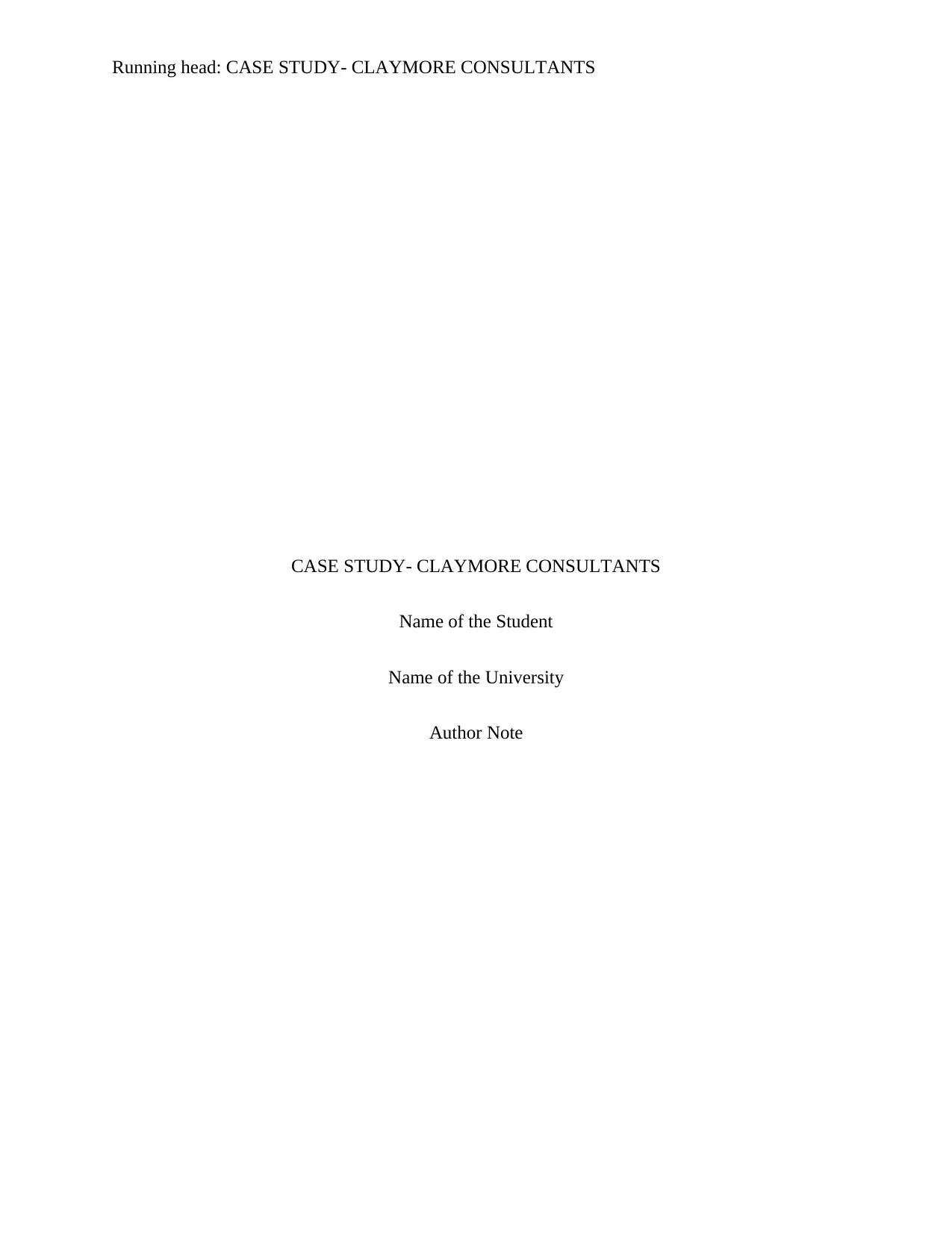
Running head: CASE STUDY- CLAYMORE CONSULTANTS
CASE STUDY- CLAYMORE CONSULTANTS
Name of the Student
Name of the University
Author Note
CASE STUDY- CLAYMORE CONSULTANTS
Name of the Student
Name of the University
Author Note
Secure Best Marks with AI Grader
Need help grading? Try our AI Grader for instant feedback on your assignments.
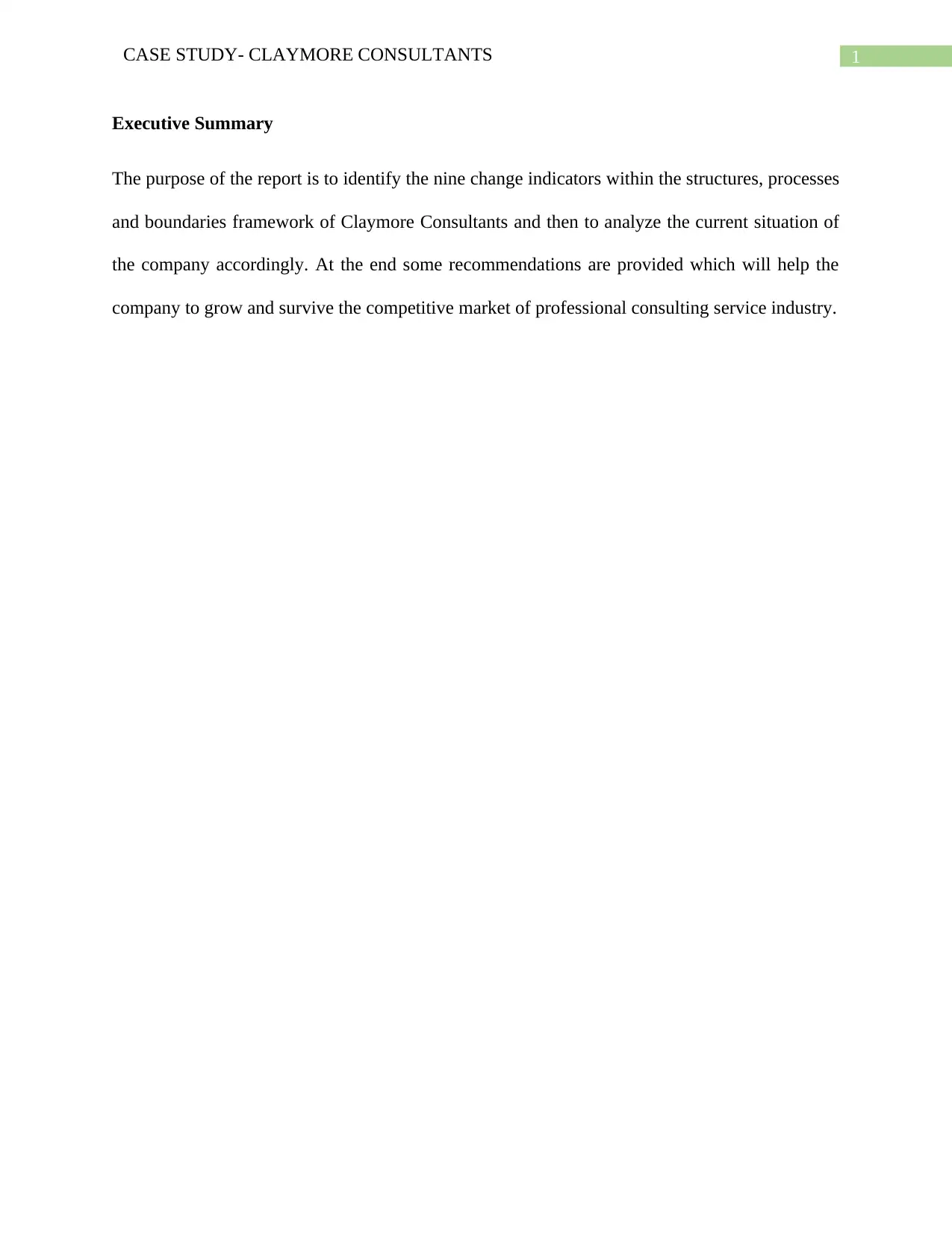
1CASE STUDY- CLAYMORE CONSULTANTS
Executive Summary
The purpose of the report is to identify the nine change indicators within the structures, processes
and boundaries framework of Claymore Consultants and then to analyze the current situation of
the company accordingly. At the end some recommendations are provided which will help the
company to grow and survive the competitive market of professional consulting service industry.
Executive Summary
The purpose of the report is to identify the nine change indicators within the structures, processes
and boundaries framework of Claymore Consultants and then to analyze the current situation of
the company accordingly. At the end some recommendations are provided which will help the
company to grow and survive the competitive market of professional consulting service industry.
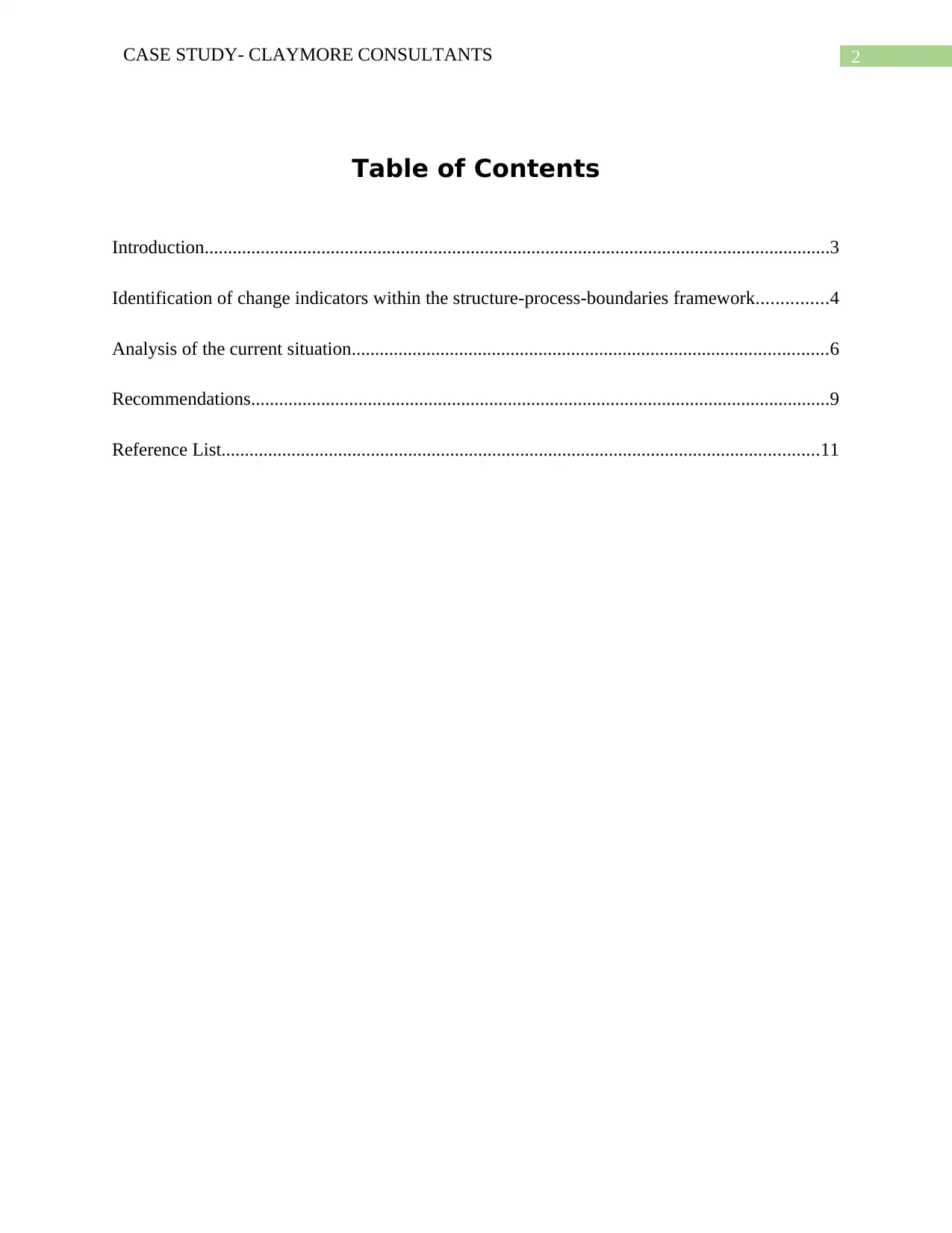
2CASE STUDY- CLAYMORE CONSULTANTS
Table of Contents
Introduction......................................................................................................................................3
Identification of change indicators within the structure-process-boundaries framework...............4
Analysis of the current situation......................................................................................................6
Recommendations............................................................................................................................9
Reference List................................................................................................................................11
Table of Contents
Introduction......................................................................................................................................3
Identification of change indicators within the structure-process-boundaries framework...............4
Analysis of the current situation......................................................................................................6
Recommendations............................................................................................................................9
Reference List................................................................................................................................11
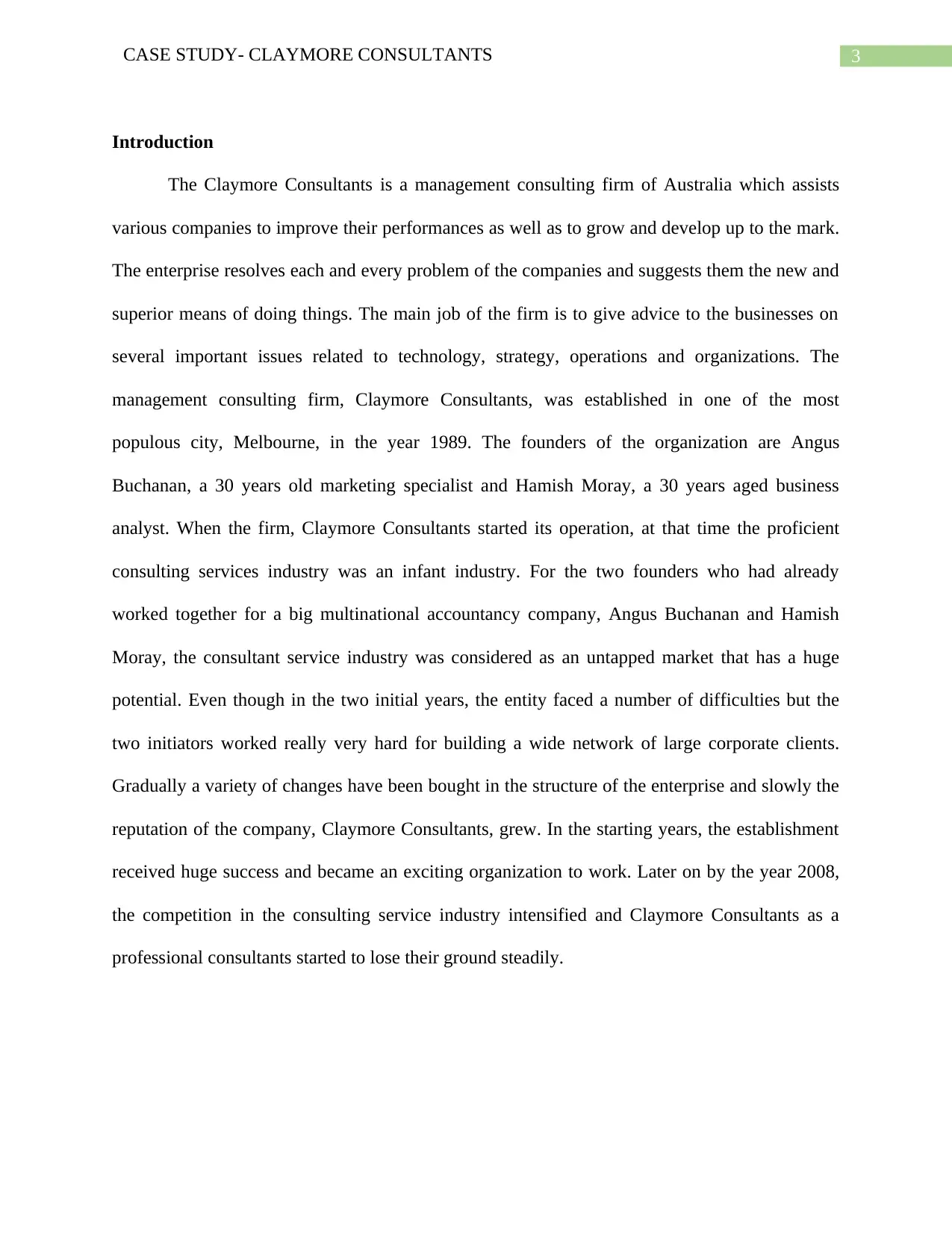
3CASE STUDY- CLAYMORE CONSULTANTS
Introduction
The Claymore Consultants is a management consulting firm of Australia which assists
various companies to improve their performances as well as to grow and develop up to the mark.
The enterprise resolves each and every problem of the companies and suggests them the new and
superior means of doing things. The main job of the firm is to give advice to the businesses on
several important issues related to technology, strategy, operations and organizations. The
management consulting firm, Claymore Consultants, was established in one of the most
populous city, Melbourne, in the year 1989. The founders of the organization are Angus
Buchanan, a 30 years old marketing specialist and Hamish Moray, a 30 years aged business
analyst. When the firm, Claymore Consultants started its operation, at that time the proficient
consulting services industry was an infant industry. For the two founders who had already
worked together for a big multinational accountancy company, Angus Buchanan and Hamish
Moray, the consultant service industry was considered as an untapped market that has a huge
potential. Even though in the two initial years, the entity faced a number of difficulties but the
two initiators worked really very hard for building a wide network of large corporate clients.
Gradually a variety of changes have been bought in the structure of the enterprise and slowly the
reputation of the company, Claymore Consultants, grew. In the starting years, the establishment
received huge success and became an exciting organization to work. Later on by the year 2008,
the competition in the consulting service industry intensified and Claymore Consultants as a
professional consultants started to lose their ground steadily.
Introduction
The Claymore Consultants is a management consulting firm of Australia which assists
various companies to improve their performances as well as to grow and develop up to the mark.
The enterprise resolves each and every problem of the companies and suggests them the new and
superior means of doing things. The main job of the firm is to give advice to the businesses on
several important issues related to technology, strategy, operations and organizations. The
management consulting firm, Claymore Consultants, was established in one of the most
populous city, Melbourne, in the year 1989. The founders of the organization are Angus
Buchanan, a 30 years old marketing specialist and Hamish Moray, a 30 years aged business
analyst. When the firm, Claymore Consultants started its operation, at that time the proficient
consulting services industry was an infant industry. For the two founders who had already
worked together for a big multinational accountancy company, Angus Buchanan and Hamish
Moray, the consultant service industry was considered as an untapped market that has a huge
potential. Even though in the two initial years, the entity faced a number of difficulties but the
two initiators worked really very hard for building a wide network of large corporate clients.
Gradually a variety of changes have been bought in the structure of the enterprise and slowly the
reputation of the company, Claymore Consultants, grew. In the starting years, the establishment
received huge success and became an exciting organization to work. Later on by the year 2008,
the competition in the consulting service industry intensified and Claymore Consultants as a
professional consultants started to lose their ground steadily.
Secure Best Marks with AI Grader
Need help grading? Try our AI Grader for instant feedback on your assignments.
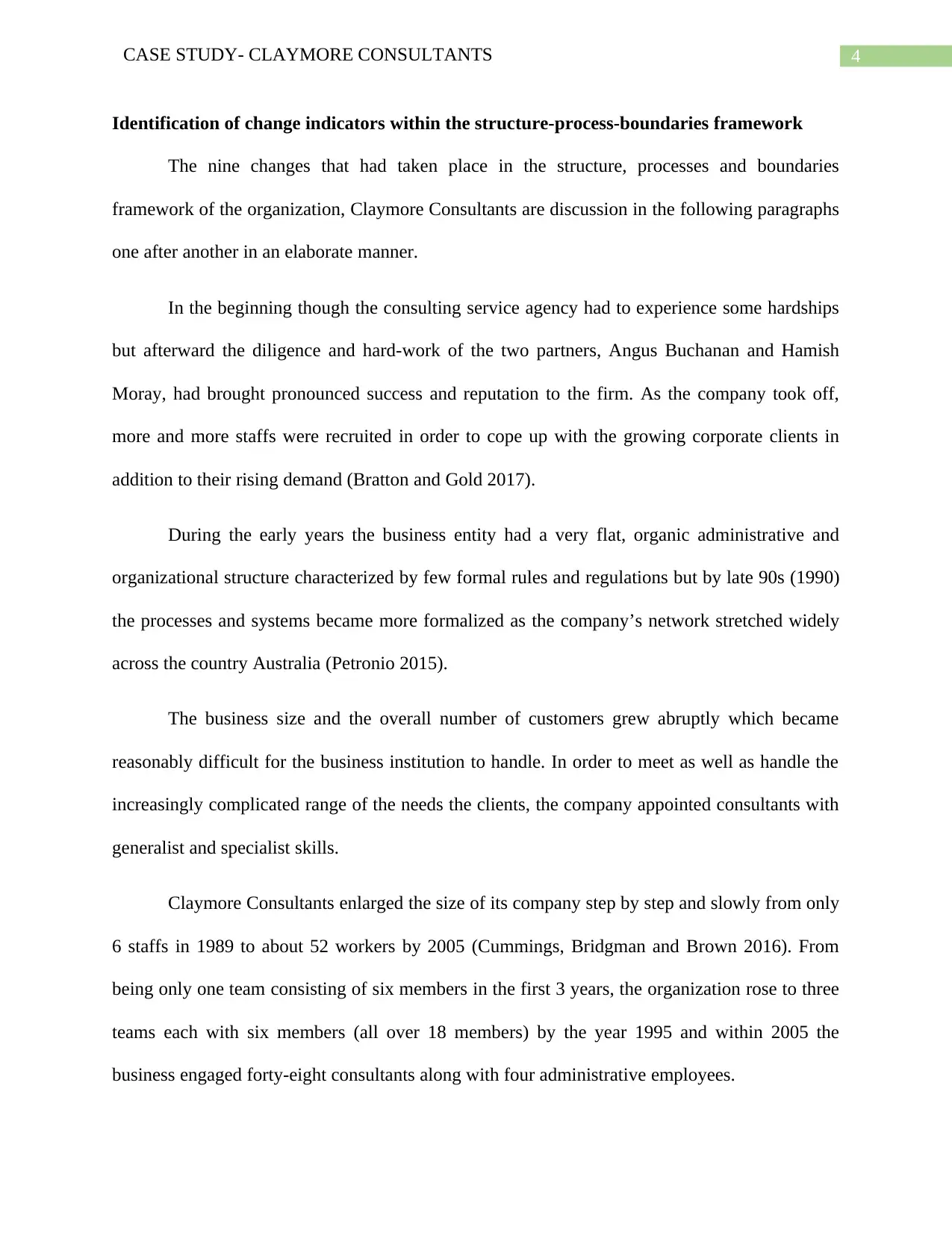
4CASE STUDY- CLAYMORE CONSULTANTS
Identification of change indicators within the structure-process-boundaries framework
The nine changes that had taken place in the structure, processes and boundaries
framework of the organization, Claymore Consultants are discussion in the following paragraphs
one after another in an elaborate manner.
In the beginning though the consulting service agency had to experience some hardships
but afterward the diligence and hard-work of the two partners, Angus Buchanan and Hamish
Moray, had brought pronounced success and reputation to the firm. As the company took off,
more and more staffs were recruited in order to cope up with the growing corporate clients in
addition to their rising demand (Bratton and Gold 2017).
During the early years the business entity had a very flat, organic administrative and
organizational structure characterized by few formal rules and regulations but by late 90s (1990)
the processes and systems became more formalized as the company’s network stretched widely
across the country Australia (Petronio 2015).
The business size and the overall number of customers grew abruptly which became
reasonably difficult for the business institution to handle. In order to meet as well as handle the
increasingly complicated range of the needs the clients, the company appointed consultants with
generalist and specialist skills.
Claymore Consultants enlarged the size of its company step by step and slowly from only
6 staffs in 1989 to about 52 workers by 2005 (Cummings, Bridgman and Brown 2016). From
being only one team consisting of six members in the first 3 years, the organization rose to three
teams each with six members (all over 18 members) by the year 1995 and within 2005 the
business engaged forty-eight consultants along with four administrative employees.
Identification of change indicators within the structure-process-boundaries framework
The nine changes that had taken place in the structure, processes and boundaries
framework of the organization, Claymore Consultants are discussion in the following paragraphs
one after another in an elaborate manner.
In the beginning though the consulting service agency had to experience some hardships
but afterward the diligence and hard-work of the two partners, Angus Buchanan and Hamish
Moray, had brought pronounced success and reputation to the firm. As the company took off,
more and more staffs were recruited in order to cope up with the growing corporate clients in
addition to their rising demand (Bratton and Gold 2017).
During the early years the business entity had a very flat, organic administrative and
organizational structure characterized by few formal rules and regulations but by late 90s (1990)
the processes and systems became more formalized as the company’s network stretched widely
across the country Australia (Petronio 2015).
The business size and the overall number of customers grew abruptly which became
reasonably difficult for the business institution to handle. In order to meet as well as handle the
increasingly complicated range of the needs the clients, the company appointed consultants with
generalist and specialist skills.
Claymore Consultants enlarged the size of its company step by step and slowly from only
6 staffs in 1989 to about 52 workers by 2005 (Cummings, Bridgman and Brown 2016). From
being only one team consisting of six members in the first 3 years, the organization rose to three
teams each with six members (all over 18 members) by the year 1995 and within 2005 the
business engaged forty-eight consultants along with four administrative employees.
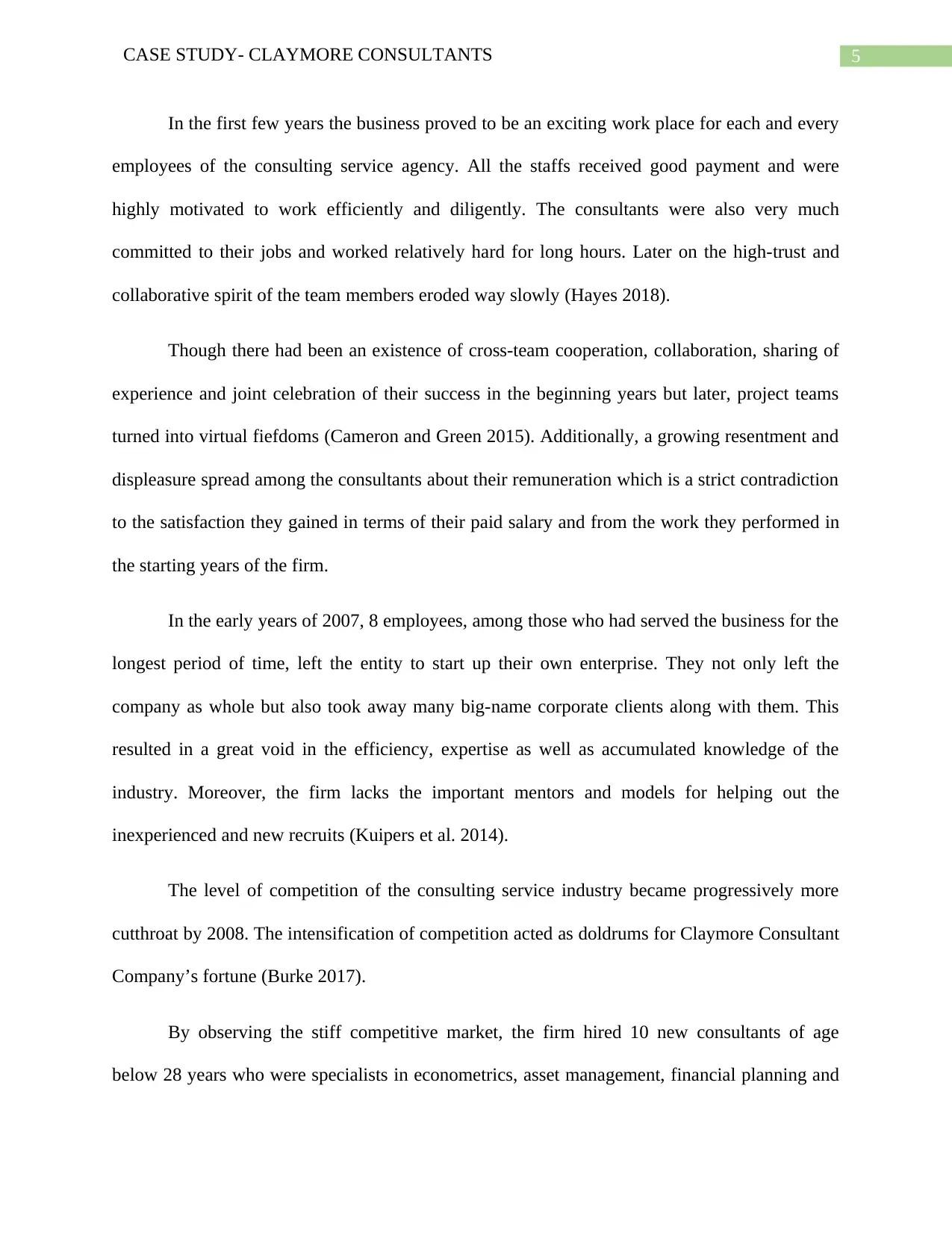
5CASE STUDY- CLAYMORE CONSULTANTS
In the first few years the business proved to be an exciting work place for each and every
employees of the consulting service agency. All the staffs received good payment and were
highly motivated to work efficiently and diligently. The consultants were also very much
committed to their jobs and worked relatively hard for long hours. Later on the high-trust and
collaborative spirit of the team members eroded way slowly (Hayes 2018).
Though there had been an existence of cross-team cooperation, collaboration, sharing of
experience and joint celebration of their success in the beginning years but later, project teams
turned into virtual fiefdoms (Cameron and Green 2015). Additionally, a growing resentment and
displeasure spread among the consultants about their remuneration which is a strict contradiction
to the satisfaction they gained in terms of their paid salary and from the work they performed in
the starting years of the firm.
In the early years of 2007, 8 employees, among those who had served the business for the
longest period of time, left the entity to start up their own enterprise. They not only left the
company as whole but also took away many big-name corporate clients along with them. This
resulted in a great void in the efficiency, expertise as well as accumulated knowledge of the
industry. Moreover, the firm lacks the important mentors and models for helping out the
inexperienced and new recruits (Kuipers et al. 2014).
The level of competition of the consulting service industry became progressively more
cutthroat by 2008. The intensification of competition acted as doldrums for Claymore Consultant
Company’s fortune (Burke 2017).
By observing the stiff competitive market, the firm hired 10 new consultants of age
below 28 years who were specialists in econometrics, asset management, financial planning and
In the first few years the business proved to be an exciting work place for each and every
employees of the consulting service agency. All the staffs received good payment and were
highly motivated to work efficiently and diligently. The consultants were also very much
committed to their jobs and worked relatively hard for long hours. Later on the high-trust and
collaborative spirit of the team members eroded way slowly (Hayes 2018).
Though there had been an existence of cross-team cooperation, collaboration, sharing of
experience and joint celebration of their success in the beginning years but later, project teams
turned into virtual fiefdoms (Cameron and Green 2015). Additionally, a growing resentment and
displeasure spread among the consultants about their remuneration which is a strict contradiction
to the satisfaction they gained in terms of their paid salary and from the work they performed in
the starting years of the firm.
In the early years of 2007, 8 employees, among those who had served the business for the
longest period of time, left the entity to start up their own enterprise. They not only left the
company as whole but also took away many big-name corporate clients along with them. This
resulted in a great void in the efficiency, expertise as well as accumulated knowledge of the
industry. Moreover, the firm lacks the important mentors and models for helping out the
inexperienced and new recruits (Kuipers et al. 2014).
The level of competition of the consulting service industry became progressively more
cutthroat by 2008. The intensification of competition acted as doldrums for Claymore Consultant
Company’s fortune (Burke 2017).
By observing the stiff competitive market, the firm hired 10 new consultants of age
below 28 years who were specialists in econometrics, asset management, financial planning and
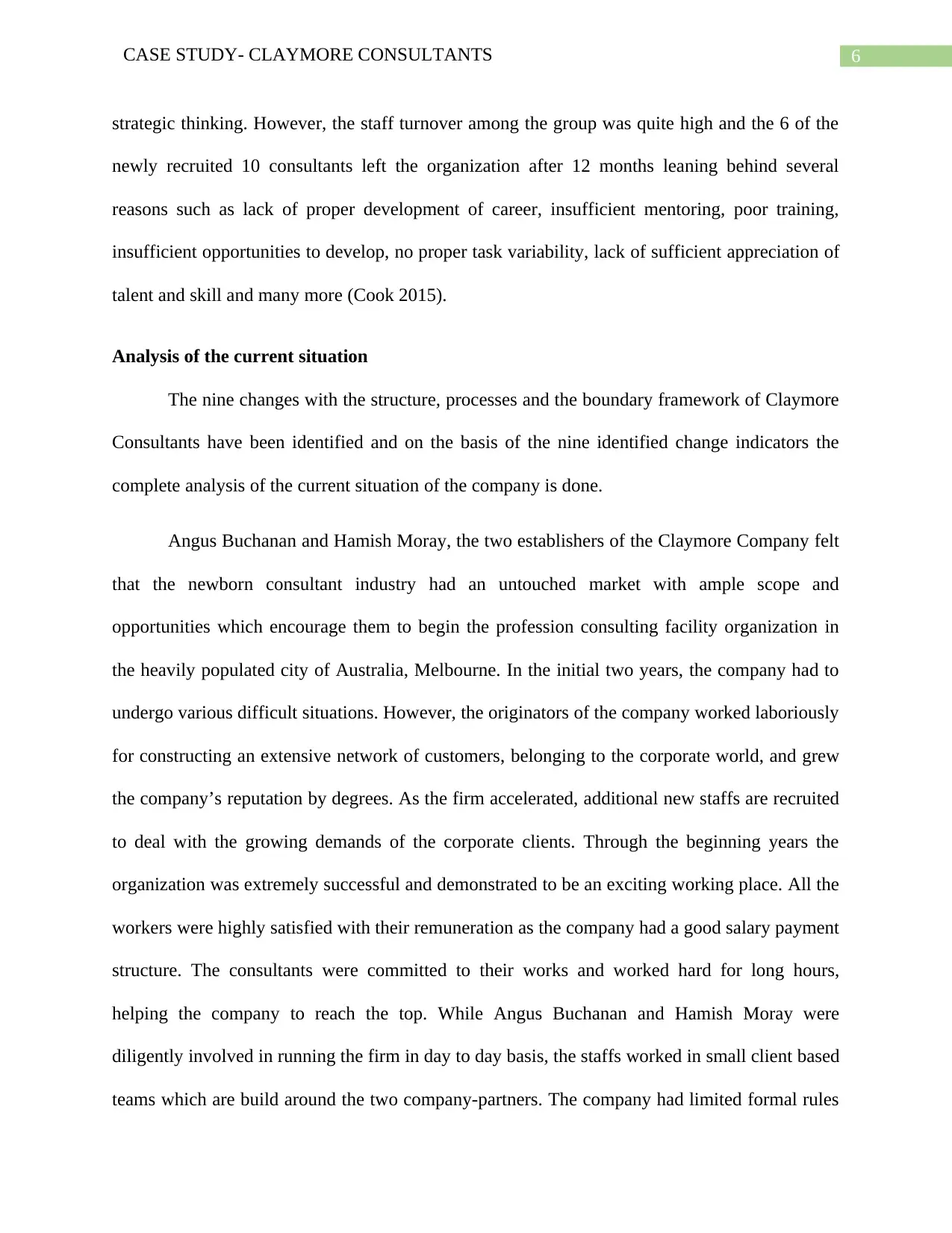
6CASE STUDY- CLAYMORE CONSULTANTS
strategic thinking. However, the staff turnover among the group was quite high and the 6 of the
newly recruited 10 consultants left the organization after 12 months leaning behind several
reasons such as lack of proper development of career, insufficient mentoring, poor training,
insufficient opportunities to develop, no proper task variability, lack of sufficient appreciation of
talent and skill and many more (Cook 2015).
Analysis of the current situation
The nine changes with the structure, processes and the boundary framework of Claymore
Consultants have been identified and on the basis of the nine identified change indicators the
complete analysis of the current situation of the company is done.
Angus Buchanan and Hamish Moray, the two establishers of the Claymore Company felt
that the newborn consultant industry had an untouched market with ample scope and
opportunities which encourage them to begin the profession consulting facility organization in
the heavily populated city of Australia, Melbourne. In the initial two years, the company had to
undergo various difficult situations. However, the originators of the company worked laboriously
for constructing an extensive network of customers, belonging to the corporate world, and grew
the company’s reputation by degrees. As the firm accelerated, additional new staffs are recruited
to deal with the growing demands of the corporate clients. Through the beginning years the
organization was extremely successful and demonstrated to be an exciting working place. All the
workers were highly satisfied with their remuneration as the company had a good salary payment
structure. The consultants were committed to their works and worked hard for long hours,
helping the company to reach the top. While Angus Buchanan and Hamish Moray were
diligently involved in running the firm in day to day basis, the staffs worked in small client based
teams which are build around the two company-partners. The company had limited formal rules
strategic thinking. However, the staff turnover among the group was quite high and the 6 of the
newly recruited 10 consultants left the organization after 12 months leaning behind several
reasons such as lack of proper development of career, insufficient mentoring, poor training,
insufficient opportunities to develop, no proper task variability, lack of sufficient appreciation of
talent and skill and many more (Cook 2015).
Analysis of the current situation
The nine changes with the structure, processes and the boundary framework of Claymore
Consultants have been identified and on the basis of the nine identified change indicators the
complete analysis of the current situation of the company is done.
Angus Buchanan and Hamish Moray, the two establishers of the Claymore Company felt
that the newborn consultant industry had an untouched market with ample scope and
opportunities which encourage them to begin the profession consulting facility organization in
the heavily populated city of Australia, Melbourne. In the initial two years, the company had to
undergo various difficult situations. However, the originators of the company worked laboriously
for constructing an extensive network of customers, belonging to the corporate world, and grew
the company’s reputation by degrees. As the firm accelerated, additional new staffs are recruited
to deal with the growing demands of the corporate clients. Through the beginning years the
organization was extremely successful and demonstrated to be an exciting working place. All the
workers were highly satisfied with their remuneration as the company had a good salary payment
structure. The consultants were committed to their works and worked hard for long hours,
helping the company to reach the top. While Angus Buchanan and Hamish Moray were
diligently involved in running the firm in day to day basis, the staffs worked in small client based
teams which are build around the two company-partners. The company had limited formal rules
Paraphrase This Document
Need a fresh take? Get an instant paraphrase of this document with our AI Paraphraser
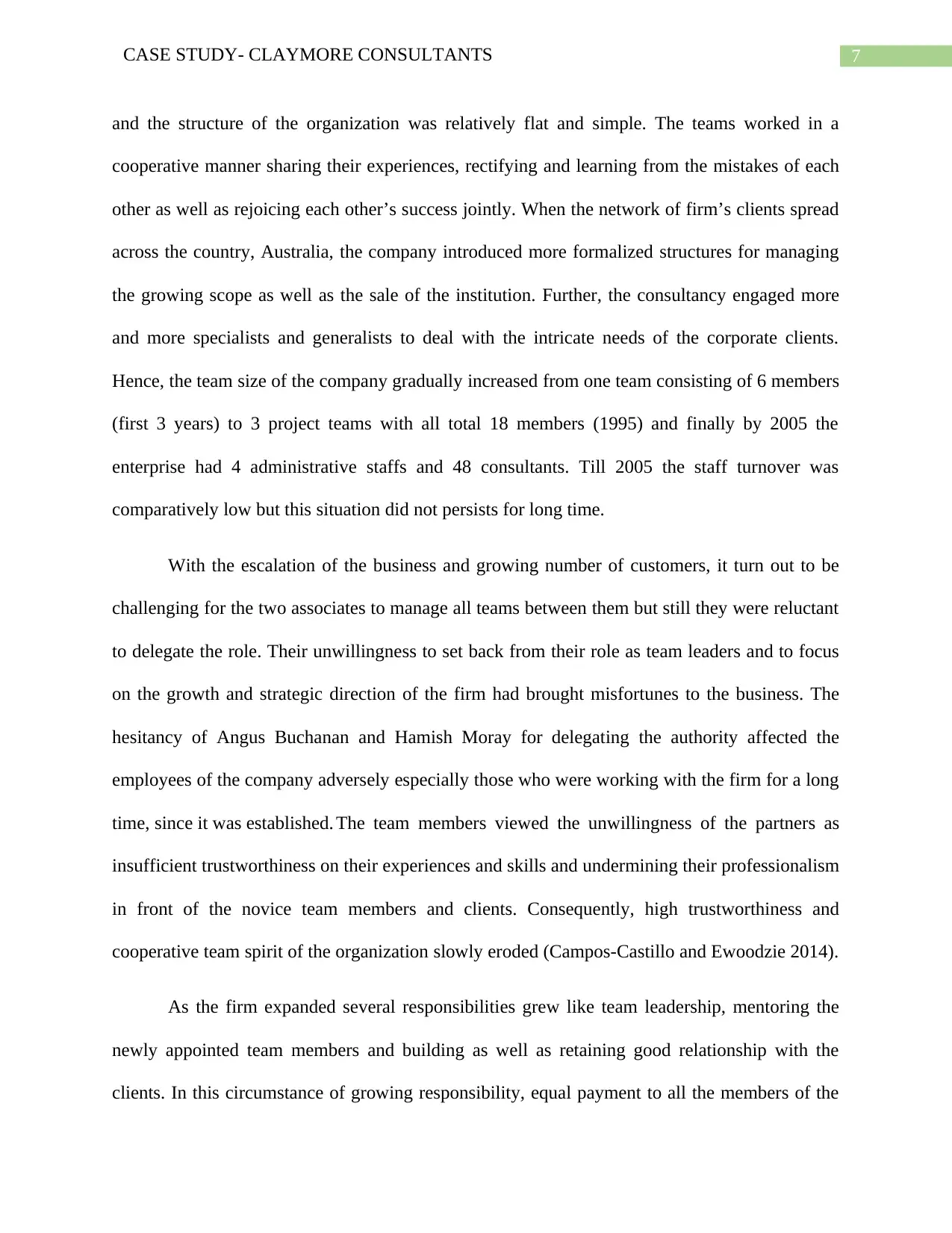
7CASE STUDY- CLAYMORE CONSULTANTS
and the structure of the organization was relatively flat and simple. The teams worked in a
cooperative manner sharing their experiences, rectifying and learning from the mistakes of each
other as well as rejoicing each other’s success jointly. When the network of firm’s clients spread
across the country, Australia, the company introduced more formalized structures for managing
the growing scope as well as the sale of the institution. Further, the consultancy engaged more
and more specialists and generalists to deal with the intricate needs of the corporate clients.
Hence, the team size of the company gradually increased from one team consisting of 6 members
(first 3 years) to 3 project teams with all total 18 members (1995) and finally by 2005 the
enterprise had 4 administrative staffs and 48 consultants. Till 2005 the staff turnover was
comparatively low but this situation did not persists for long time.
With the escalation of the business and growing number of customers, it turn out to be
challenging for the two associates to manage all teams between them but still they were reluctant
to delegate the role. Their unwillingness to set back from their role as team leaders and to focus
on the growth and strategic direction of the firm had brought misfortunes to the business. The
hesitancy of Angus Buchanan and Hamish Moray for delegating the authority affected the
employees of the company adversely especially those who were working with the firm for a long
time, since it was established. The team members viewed the unwillingness of the partners as
insufficient trustworthiness on their experiences and skills and undermining their professionalism
in front of the novice team members and clients. Consequently, high trustworthiness and
cooperative team spirit of the organization slowly eroded (Campos-Castillo and Ewoodzie 2014).
As the firm expanded several responsibilities grew like team leadership, mentoring the
newly appointed team members and building as well as retaining good relationship with the
clients. In this circumstance of growing responsibility, equal payment to all the members of the
and the structure of the organization was relatively flat and simple. The teams worked in a
cooperative manner sharing their experiences, rectifying and learning from the mistakes of each
other as well as rejoicing each other’s success jointly. When the network of firm’s clients spread
across the country, Australia, the company introduced more formalized structures for managing
the growing scope as well as the sale of the institution. Further, the consultancy engaged more
and more specialists and generalists to deal with the intricate needs of the corporate clients.
Hence, the team size of the company gradually increased from one team consisting of 6 members
(first 3 years) to 3 project teams with all total 18 members (1995) and finally by 2005 the
enterprise had 4 administrative staffs and 48 consultants. Till 2005 the staff turnover was
comparatively low but this situation did not persists for long time.
With the escalation of the business and growing number of customers, it turn out to be
challenging for the two associates to manage all teams between them but still they were reluctant
to delegate the role. Their unwillingness to set back from their role as team leaders and to focus
on the growth and strategic direction of the firm had brought misfortunes to the business. The
hesitancy of Angus Buchanan and Hamish Moray for delegating the authority affected the
employees of the company adversely especially those who were working with the firm for a long
time, since it was established. The team members viewed the unwillingness of the partners as
insufficient trustworthiness on their experiences and skills and undermining their professionalism
in front of the novice team members and clients. Consequently, high trustworthiness and
cooperative team spirit of the organization slowly eroded (Campos-Castillo and Ewoodzie 2014).
As the firm expanded several responsibilities grew like team leadership, mentoring the
newly appointed team members and building as well as retaining good relationship with the
clients. In this circumstance of growing responsibility, equal payment to all the members of the
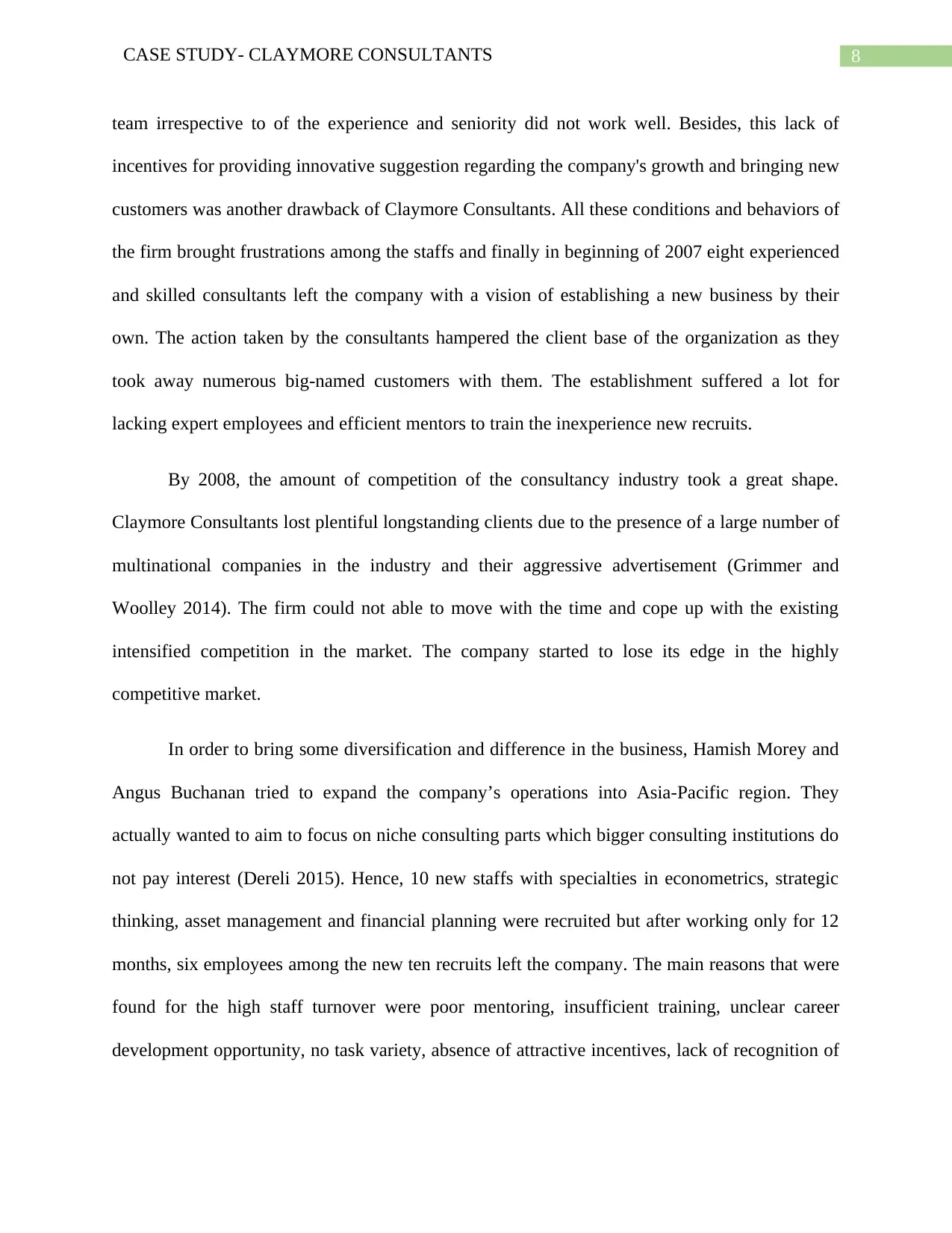
8CASE STUDY- CLAYMORE CONSULTANTS
team irrespective to of the experience and seniority did not work well. Besides, this lack of
incentives for providing innovative suggestion regarding the company's growth and bringing new
customers was another drawback of Claymore Consultants. All these conditions and behaviors of
the firm brought frustrations among the staffs and finally in beginning of 2007 eight experienced
and skilled consultants left the company with a vision of establishing a new business by their
own. The action taken by the consultants hampered the client base of the organization as they
took away numerous big-named customers with them. The establishment suffered a lot for
lacking expert employees and efficient mentors to train the inexperience new recruits.
By 2008, the amount of competition of the consultancy industry took a great shape.
Claymore Consultants lost plentiful longstanding clients due to the presence of a large number of
multinational companies in the industry and their aggressive advertisement (Grimmer and
Woolley 2014). The firm could not able to move with the time and cope up with the existing
intensified competition in the market. The company started to lose its edge in the highly
competitive market.
In order to bring some diversification and difference in the business, Hamish Morey and
Angus Buchanan tried to expand the company’s operations into Asia-Pacific region. They
actually wanted to aim to focus on niche consulting parts which bigger consulting institutions do
not pay interest (Dereli 2015). Hence, 10 new staffs with specialties in econometrics, strategic
thinking, asset management and financial planning were recruited but after working only for 12
months, six employees among the new ten recruits left the company. The main reasons that were
found for the high staff turnover were poor mentoring, insufficient training, unclear career
development opportunity, no task variety, absence of attractive incentives, lack of recognition of
team irrespective to of the experience and seniority did not work well. Besides, this lack of
incentives for providing innovative suggestion regarding the company's growth and bringing new
customers was another drawback of Claymore Consultants. All these conditions and behaviors of
the firm brought frustrations among the staffs and finally in beginning of 2007 eight experienced
and skilled consultants left the company with a vision of establishing a new business by their
own. The action taken by the consultants hampered the client base of the organization as they
took away numerous big-named customers with them. The establishment suffered a lot for
lacking expert employees and efficient mentors to train the inexperience new recruits.
By 2008, the amount of competition of the consultancy industry took a great shape.
Claymore Consultants lost plentiful longstanding clients due to the presence of a large number of
multinational companies in the industry and their aggressive advertisement (Grimmer and
Woolley 2014). The firm could not able to move with the time and cope up with the existing
intensified competition in the market. The company started to lose its edge in the highly
competitive market.
In order to bring some diversification and difference in the business, Hamish Morey and
Angus Buchanan tried to expand the company’s operations into Asia-Pacific region. They
actually wanted to aim to focus on niche consulting parts which bigger consulting institutions do
not pay interest (Dereli 2015). Hence, 10 new staffs with specialties in econometrics, strategic
thinking, asset management and financial planning were recruited but after working only for 12
months, six employees among the new ten recruits left the company. The main reasons that were
found for the high staff turnover were poor mentoring, insufficient training, unclear career
development opportunity, no task variety, absence of attractive incentives, lack of recognition of
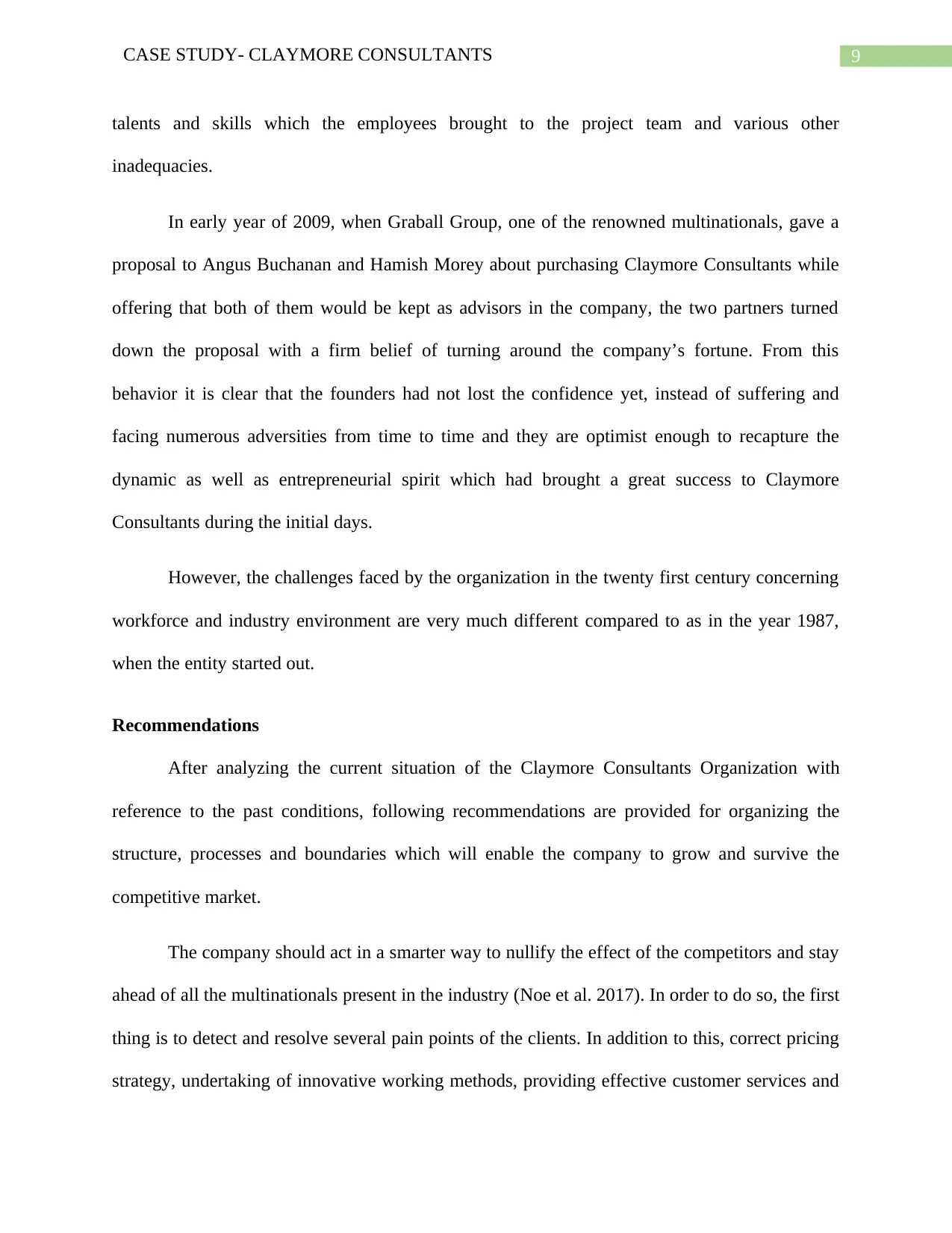
9CASE STUDY- CLAYMORE CONSULTANTS
talents and skills which the employees brought to the project team and various other
inadequacies.
In early year of 2009, when Graball Group, one of the renowned multinationals, gave a
proposal to Angus Buchanan and Hamish Morey about purchasing Claymore Consultants while
offering that both of them would be kept as advisors in the company, the two partners turned
down the proposal with a firm belief of turning around the company’s fortune. From this
behavior it is clear that the founders had not lost the confidence yet, instead of suffering and
facing numerous adversities from time to time and they are optimist enough to recapture the
dynamic as well as entrepreneurial spirit which had brought a great success to Claymore
Consultants during the initial days.
However, the challenges faced by the organization in the twenty first century concerning
workforce and industry environment are very much different compared to as in the year 1987,
when the entity started out.
Recommendations
After analyzing the current situation of the Claymore Consultants Organization with
reference to the past conditions, following recommendations are provided for organizing the
structure, processes and boundaries which will enable the company to grow and survive the
competitive market.
The company should act in a smarter way to nullify the effect of the competitors and stay
ahead of all the multinationals present in the industry (Noe et al. 2017). In order to do so, the first
thing is to detect and resolve several pain points of the clients. In addition to this, correct pricing
strategy, undertaking of innovative working methods, providing effective customer services and
talents and skills which the employees brought to the project team and various other
inadequacies.
In early year of 2009, when Graball Group, one of the renowned multinationals, gave a
proposal to Angus Buchanan and Hamish Morey about purchasing Claymore Consultants while
offering that both of them would be kept as advisors in the company, the two partners turned
down the proposal with a firm belief of turning around the company’s fortune. From this
behavior it is clear that the founders had not lost the confidence yet, instead of suffering and
facing numerous adversities from time to time and they are optimist enough to recapture the
dynamic as well as entrepreneurial spirit which had brought a great success to Claymore
Consultants during the initial days.
However, the challenges faced by the organization in the twenty first century concerning
workforce and industry environment are very much different compared to as in the year 1987,
when the entity started out.
Recommendations
After analyzing the current situation of the Claymore Consultants Organization with
reference to the past conditions, following recommendations are provided for organizing the
structure, processes and boundaries which will enable the company to grow and survive the
competitive market.
The company should act in a smarter way to nullify the effect of the competitors and stay
ahead of all the multinationals present in the industry (Noe et al. 2017). In order to do so, the first
thing is to detect and resolve several pain points of the clients. In addition to this, correct pricing
strategy, undertaking of innovative working methods, providing effective customer services and
Secure Best Marks with AI Grader
Need help grading? Try our AI Grader for instant feedback on your assignments.
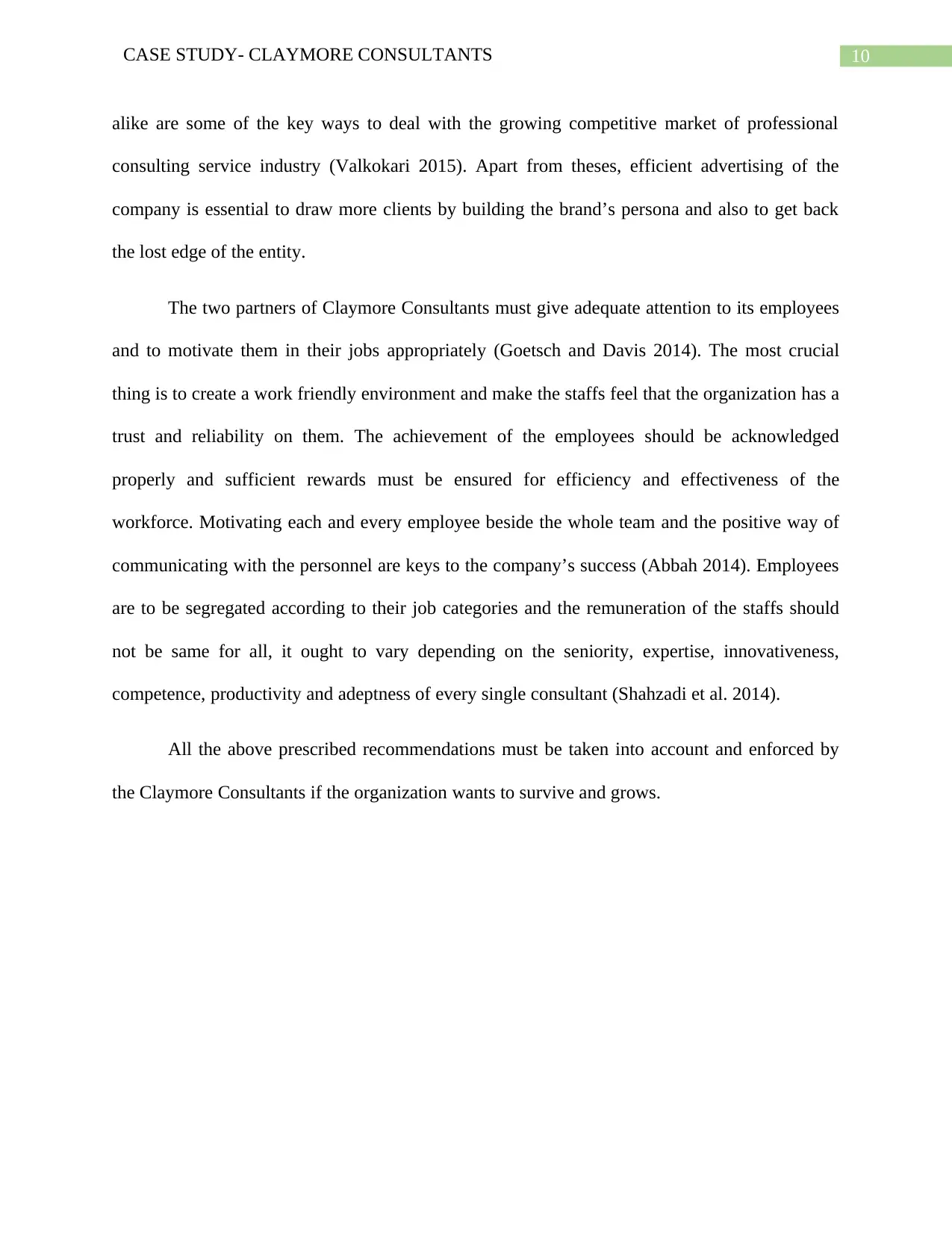
10CASE STUDY- CLAYMORE CONSULTANTS
alike are some of the key ways to deal with the growing competitive market of professional
consulting service industry (Valkokari 2015). Apart from theses, efficient advertising of the
company is essential to draw more clients by building the brand’s persona and also to get back
the lost edge of the entity.
The two partners of Claymore Consultants must give adequate attention to its employees
and to motivate them in their jobs appropriately (Goetsch and Davis 2014). The most crucial
thing is to create a work friendly environment and make the staffs feel that the organization has a
trust and reliability on them. The achievement of the employees should be acknowledged
properly and sufficient rewards must be ensured for efficiency and effectiveness of the
workforce. Motivating each and every employee beside the whole team and the positive way of
communicating with the personnel are keys to the company’s success (Abbah 2014). Employees
are to be segregated according to their job categories and the remuneration of the staffs should
not be same for all, it ought to vary depending on the seniority, expertise, innovativeness,
competence, productivity and adeptness of every single consultant (Shahzadi et al. 2014).
All the above prescribed recommendations must be taken into account and enforced by
the Claymore Consultants if the organization wants to survive and grows.
alike are some of the key ways to deal with the growing competitive market of professional
consulting service industry (Valkokari 2015). Apart from theses, efficient advertising of the
company is essential to draw more clients by building the brand’s persona and also to get back
the lost edge of the entity.
The two partners of Claymore Consultants must give adequate attention to its employees
and to motivate them in their jobs appropriately (Goetsch and Davis 2014). The most crucial
thing is to create a work friendly environment and make the staffs feel that the organization has a
trust and reliability on them. The achievement of the employees should be acknowledged
properly and sufficient rewards must be ensured for efficiency and effectiveness of the
workforce. Motivating each and every employee beside the whole team and the positive way of
communicating with the personnel are keys to the company’s success (Abbah 2014). Employees
are to be segregated according to their job categories and the remuneration of the staffs should
not be same for all, it ought to vary depending on the seniority, expertise, innovativeness,
competence, productivity and adeptness of every single consultant (Shahzadi et al. 2014).
All the above prescribed recommendations must be taken into account and enforced by
the Claymore Consultants if the organization wants to survive and grows.
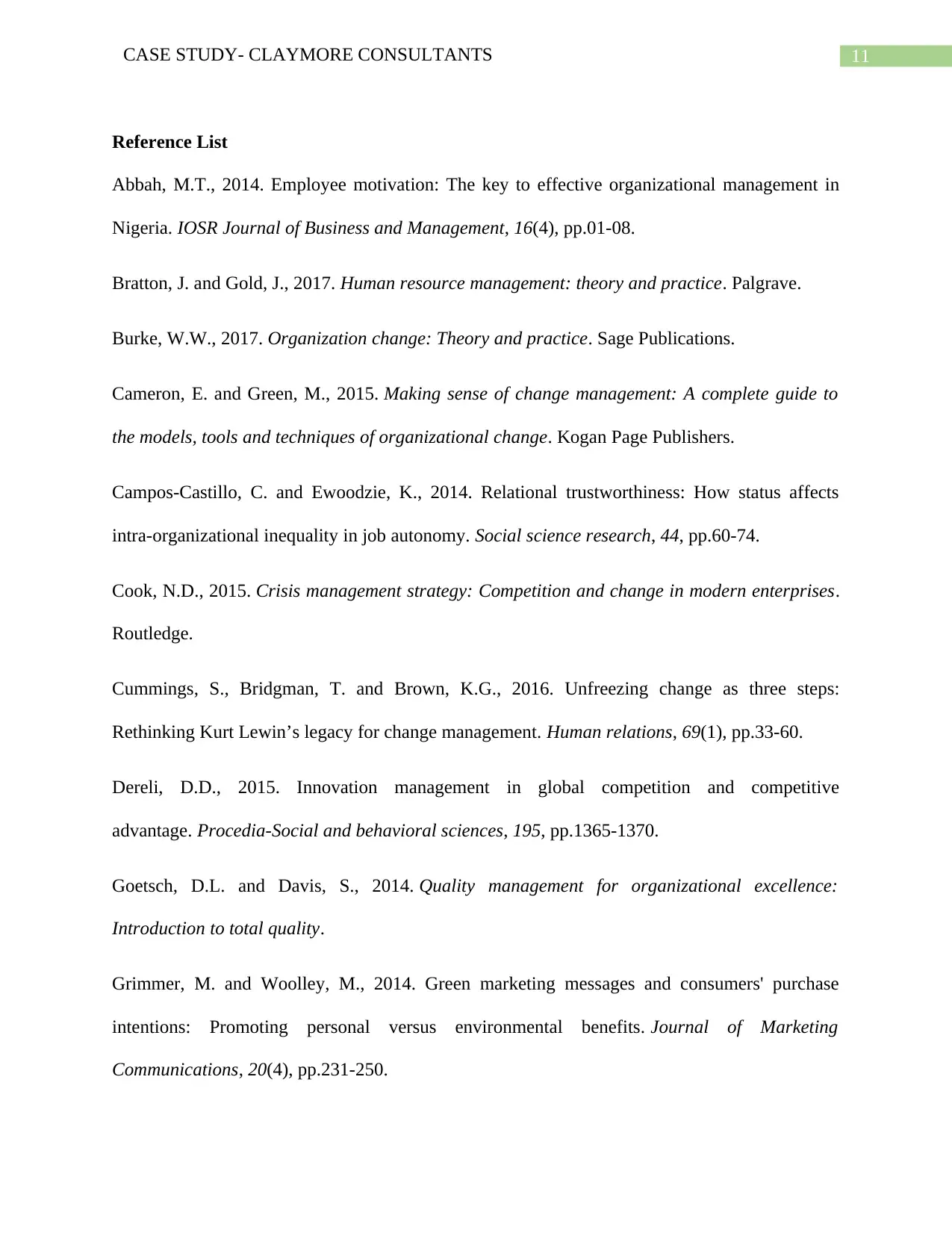
11CASE STUDY- CLAYMORE CONSULTANTS
Reference List
Abbah, M.T., 2014. Employee motivation: The key to effective organizational management in
Nigeria. IOSR Journal of Business and Management, 16(4), pp.01-08.
Bratton, J. and Gold, J., 2017. Human resource management: theory and practice. Palgrave.
Burke, W.W., 2017. Organization change: Theory and practice. Sage Publications.
Cameron, E. and Green, M., 2015. Making sense of change management: A complete guide to
the models, tools and techniques of organizational change. Kogan Page Publishers.
Campos-Castillo, C. and Ewoodzie, K., 2014. Relational trustworthiness: How status affects
intra-organizational inequality in job autonomy. Social science research, 44, pp.60-74.
Cook, N.D., 2015. Crisis management strategy: Competition and change in modern enterprises.
Routledge.
Cummings, S., Bridgman, T. and Brown, K.G., 2016. Unfreezing change as three steps:
Rethinking Kurt Lewin’s legacy for change management. Human relations, 69(1), pp.33-60.
Dereli, D.D., 2015. Innovation management in global competition and competitive
advantage. Procedia-Social and behavioral sciences, 195, pp.1365-1370.
Goetsch, D.L. and Davis, S., 2014. Quality management for organizational excellence:
Introduction to total quality.
Grimmer, M. and Woolley, M., 2014. Green marketing messages and consumers' purchase
intentions: Promoting personal versus environmental benefits. Journal of Marketing
Communications, 20(4), pp.231-250.
Reference List
Abbah, M.T., 2014. Employee motivation: The key to effective organizational management in
Nigeria. IOSR Journal of Business and Management, 16(4), pp.01-08.
Bratton, J. and Gold, J., 2017. Human resource management: theory and practice. Palgrave.
Burke, W.W., 2017. Organization change: Theory and practice. Sage Publications.
Cameron, E. and Green, M., 2015. Making sense of change management: A complete guide to
the models, tools and techniques of organizational change. Kogan Page Publishers.
Campos-Castillo, C. and Ewoodzie, K., 2014. Relational trustworthiness: How status affects
intra-organizational inequality in job autonomy. Social science research, 44, pp.60-74.
Cook, N.D., 2015. Crisis management strategy: Competition and change in modern enterprises.
Routledge.
Cummings, S., Bridgman, T. and Brown, K.G., 2016. Unfreezing change as three steps:
Rethinking Kurt Lewin’s legacy for change management. Human relations, 69(1), pp.33-60.
Dereli, D.D., 2015. Innovation management in global competition and competitive
advantage. Procedia-Social and behavioral sciences, 195, pp.1365-1370.
Goetsch, D.L. and Davis, S., 2014. Quality management for organizational excellence:
Introduction to total quality.
Grimmer, M. and Woolley, M., 2014. Green marketing messages and consumers' purchase
intentions: Promoting personal versus environmental benefits. Journal of Marketing
Communications, 20(4), pp.231-250.
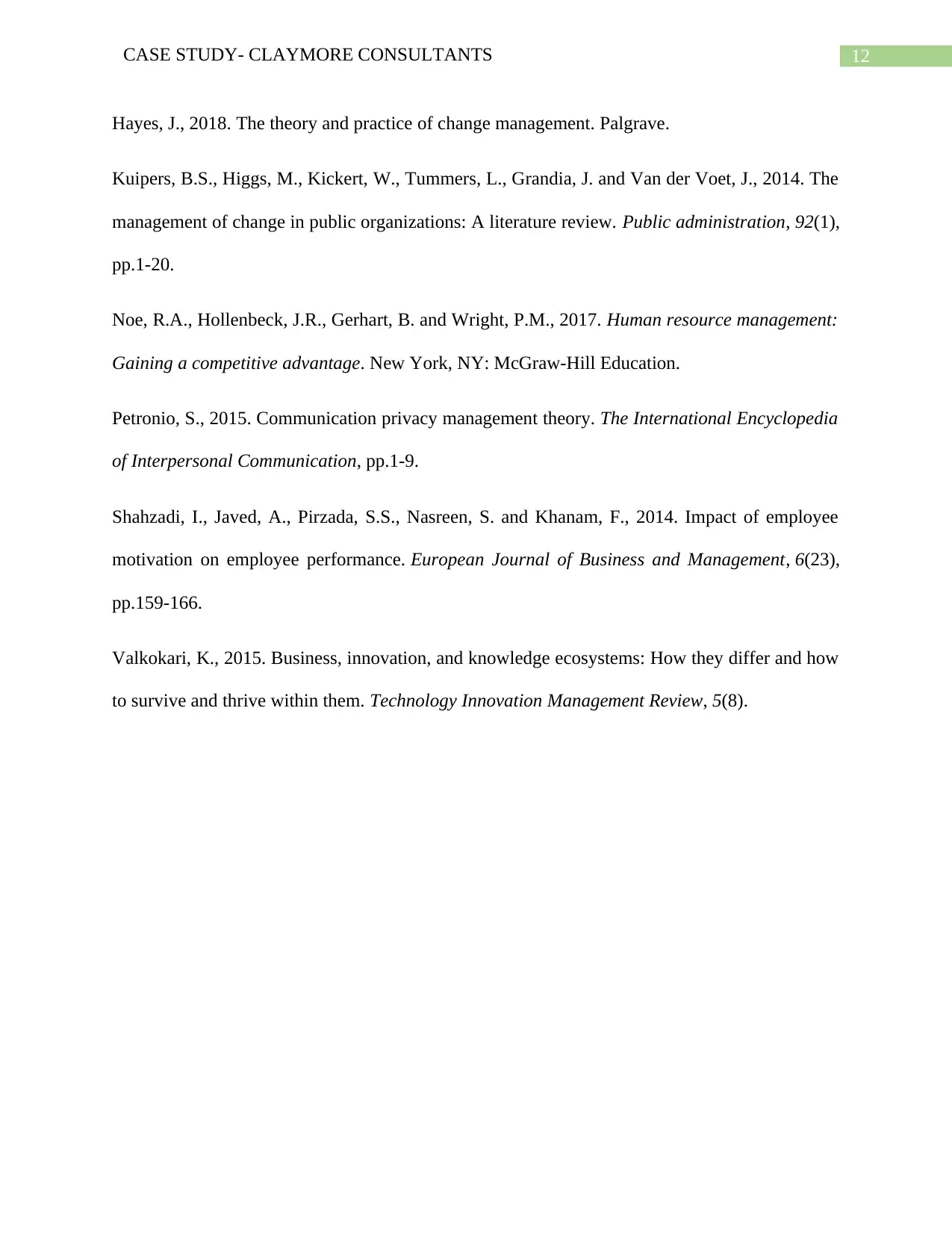
12CASE STUDY- CLAYMORE CONSULTANTS
Hayes, J., 2018. The theory and practice of change management. Palgrave.
Kuipers, B.S., Higgs, M., Kickert, W., Tummers, L., Grandia, J. and Van der Voet, J., 2014. The
management of change in public organizations: A literature review. Public administration, 92(1),
pp.1-20.
Noe, R.A., Hollenbeck, J.R., Gerhart, B. and Wright, P.M., 2017. Human resource management:
Gaining a competitive advantage. New York, NY: McGraw-Hill Education.
Petronio, S., 2015. Communication privacy management theory. The International Encyclopedia
of Interpersonal Communication, pp.1-9.
Shahzadi, I., Javed, A., Pirzada, S.S., Nasreen, S. and Khanam, F., 2014. Impact of employee
motivation on employee performance. European Journal of Business and Management, 6(23),
pp.159-166.
Valkokari, K., 2015. Business, innovation, and knowledge ecosystems: How they differ and how
to survive and thrive within them. Technology Innovation Management Review, 5(8).
Hayes, J., 2018. The theory and practice of change management. Palgrave.
Kuipers, B.S., Higgs, M., Kickert, W., Tummers, L., Grandia, J. and Van der Voet, J., 2014. The
management of change in public organizations: A literature review. Public administration, 92(1),
pp.1-20.
Noe, R.A., Hollenbeck, J.R., Gerhart, B. and Wright, P.M., 2017. Human resource management:
Gaining a competitive advantage. New York, NY: McGraw-Hill Education.
Petronio, S., 2015. Communication privacy management theory. The International Encyclopedia
of Interpersonal Communication, pp.1-9.
Shahzadi, I., Javed, A., Pirzada, S.S., Nasreen, S. and Khanam, F., 2014. Impact of employee
motivation on employee performance. European Journal of Business and Management, 6(23),
pp.159-166.
Valkokari, K., 2015. Business, innovation, and knowledge ecosystems: How they differ and how
to survive and thrive within them. Technology Innovation Management Review, 5(8).
1 out of 13
Related Documents
Your All-in-One AI-Powered Toolkit for Academic Success.
+13062052269
info@desklib.com
Available 24*7 on WhatsApp / Email
![[object Object]](/_next/static/media/star-bottom.7253800d.svg)
Unlock your academic potential
© 2024 | Zucol Services PVT LTD | All rights reserved.




